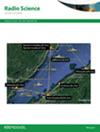Effect of ground conductivity on VLF wave propagation
IF 1.5
4区 地球科学
Q3 ASTRONOMY & ASTROPHYSICS
引用次数: 0
Abstract
Very Low Frequency (VLF, 3–30 kHz) waves propagate long distances in the waveguide formed by the Earth and the lower ionosphere. External sources such as solar flares and lightning discharges perturb the upper waveguide boundary and thereby modify the waves propagating within it. Therefore, studying the propagation of VLF waves within the waveguide enables us to probe the ionospheric response to external forcing. However, the wave propagation also depends on the lower waveguide boundary property, that is, the path conductivity. We tackle two main questions: how accurate should the path conductivity description be to obtain a given accuracy on the ionospheric electron density? Are the currently available ground-conductivity maps accurate enough? The impact of the ground conductivity values and their spatial extension on VLF wave propagation is studied through modeling with the Longwave Mode Propagator code. First, we show that knowledge of the path conductivity value should be more accurate as the ground conductivity decreases, in particular in regions where σ ≤ 10−3 S/m. Second, we find that wave propagation is strongly sensitive to the spatial extension of ground conductivity path segments: segments of a few tens of km should be included in the path description to maintain below 50% the error on the derived electron density due to the path description. These results highlight the need for an update of the ground conductivity maps, to get better spatial resolution, more accurate values, and an estimate of the time-variability of each region.地面电导率对甚低频波传播的影响
甚低频(VLF, 3 - 30khz)波在由地球和较低电离层形成的波导中长距离传播。外部源,如太阳耀斑和闪电放电干扰上波导边界,从而改变在其中传播的波。因此,研究VLF波在波导内的传播使我们能够探测电离层对外部强迫的响应。然而,波的传播还取决于下波导的边界特性,即路径电导率。我们解决了两个主要问题:路径电导率描述应该有多精确才能获得电离层电子密度的给定精度?目前可用的地面电导率图是否足够精确?利用长波模式传播器程序进行模拟,研究了地面电导率值及其空间扩展对VLF波传播的影响。首先,我们表明,随着地电导率的降低,特别是在σ≤10−3 S/m的区域,对路径电导率值的了解应该更准确。其次,我们发现波的传播对地面电导率路径段的空间延伸非常敏感:路径描述中应该包括几十公里的路段,以保持由路径描述引起的推导电子密度误差在50%以下。这些结果强调需要更新地面电导率图,以获得更好的空间分辨率,更准确的值,并估计每个区域的时间变异性。
本文章由计算机程序翻译,如有差异,请以英文原文为准。
求助全文
约1分钟内获得全文
求助全文
来源期刊

Radio Science
工程技术-地球化学与地球物理
CiteScore
3.30
自引率
12.50%
发文量
112
审稿时长
1 months
期刊介绍:
Radio Science (RDS) publishes original scientific contributions on radio-frequency electromagnetic-propagation and its applications. Contributions covering measurement, modelling, prediction and forecasting techniques pertinent to fields and waves - including antennas, signals and systems, the terrestrial and space environment and radio propagation problems in radio astronomy - are welcome. Contributions may address propagation through, interaction with, and remote sensing of structures, geophysical media, plasmas, and materials, as well as the application of radio frequency electromagnetic techniques to remote sensing of the Earth and other bodies in the solar system.
 求助内容:
求助内容: 应助结果提醒方式:
应助结果提醒方式:


